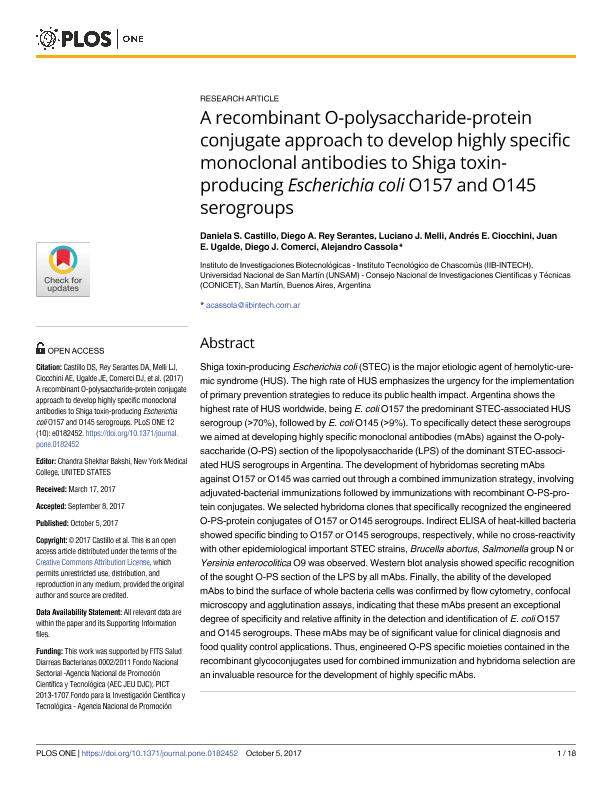Mostrar el registro sencillo del ítem
dc.contributor.author
Castillo, Daniela Susana

dc.contributor.author
Rey Serantes, Diego A.
dc.contributor.author
Melli, Luciano Jorge

dc.contributor.author
Ciocchini, Andres Eduardo

dc.contributor.author
Ugalde, Juan Esteban

dc.contributor.author
Comerci, Diego José

dc.contributor.author
Cassola, Alejandro Carlos

dc.date.available
2018-06-19T19:19:34Z
dc.date.issued
2017-10
dc.identifier.citation
Castillo, Daniela Susana; Rey Serantes, Diego A.; Melli, Luciano Jorge; Ciocchini, Andres Eduardo; Ugalde, Juan Esteban; et al.; A recombinant O-polysaccharide-protein conjugate approach to develop highly specific monoclonal antibodies to Shiga toxin-producing Escherichia coli O157 and O145 serogroups; Public Library of Science; Plos One; 12; 10; 10-2017; 1-18; e0182452
dc.identifier.issn
1932-6203
dc.identifier.uri
http://hdl.handle.net/11336/49411
dc.description.abstract
Shiga toxin-producing Escherichia coli (STEC) is the major etiologic agent of hemolytic-uremic syndrome (HUS). The high rate of HUS emphasizes the urgency for the implementation of primary prevention strategies to reduce its public health impact. Argentina shows the highest rate of HUS worldwide, being E. coli O157 the predominant STEC-associated HUS serogroup (>70%), followed by E. coli O145 (>9%). To specifically detect these serogroups we aimed at developing highly specific monoclonal antibodies (mAbs) against the O-polysaccharide (O-PS) section of the lipopolysaccharide (LPS) of the dominant STEC-associated HUS serogroups in Argentina. The development of hybridomas secreting mAbs against O157 or O145 was carried out through a combined immunization strategy, involving adjuvated-bacterial immunizations followed by immunizations with recombinant O-PS-protein conjugates. We selected hybridoma clones that specifically recognized the engineered O-PS-protein conjugates of O157 or O145 serogroups. Indirect ELISA of heat-killed bacteria showed specific binding to O157 or O145 serogroups, respectively, while no cross-reactivity with other epidemiological important STEC strains, Brucella abortus, Salmonella group N or Yersinia enterocolitica O9 was observed. Western blot analysis showed specific recognition of the sought O-PS section of the LPS by all mAbs. Finally, the ability of the developed mAbs to bind the surface of whole bacteria cells was confirmed by flow cytometry, confocal microscopy and agglutination assays, indicating that these mAbs present an exceptional degree of specificity and relative affinity in the detection and identification of E. coli O157 and O145 serogroups. These mAbs may be of significant value for clinical diagnosis and food quality control applications. Thus, engineered O-PS specific moieties contained in the recombinant glycoconjugates used for combined immunization and hybridoma selection are an invaluable resource for the development of highly specific mAbs.
dc.format
application/pdf
dc.language.iso
eng
dc.publisher
Public Library of Science

dc.rights
info:eu-repo/semantics/openAccess
dc.rights.uri
https://creativecommons.org/licenses/by-nc-sa/2.5/ar/
dc.subject
Escherichia Coli
dc.subject
Hemolytic-Uremic Syndrome
dc.subject
Monoclonal Antibodies
dc.subject
Immunodetection
dc.subject
Glycoconjugates
dc.subject
Glycoengineering
dc.subject
O157
dc.subject
O145
dc.subject.classification
Otras Ciencias Biológicas

dc.subject.classification
Ciencias Biológicas

dc.subject.classification
CIENCIAS NATURALES Y EXACTAS

dc.title
A recombinant O-polysaccharide-protein conjugate approach to develop highly specific monoclonal antibodies to Shiga toxin-producing Escherichia coli O157 and O145 serogroups
dc.type
info:eu-repo/semantics/article
dc.type
info:ar-repo/semantics/artículo
dc.type
info:eu-repo/semantics/publishedVersion
dc.date.updated
2018-06-19T17:04:16Z
dc.journal.volume
12
dc.journal.number
10
dc.journal.pagination
1-18; e0182452
dc.journal.pais
Estados Unidos

dc.journal.ciudad
San Francisco
dc.description.fil
Fil: Castillo, Daniela Susana. Consejo Nacional de Investigaciones Científicas y Técnicas. Centro Científico Tecnológico Conicet - La Plata. Instituto de Investigaciones Biotecnológicas. Universidad Nacional de San Martín. Instituto de Investigaciones Biotecnológicas; Argentina
dc.description.fil
Fil: Rey Serantes, Diego A.. Consejo Nacional de Investigaciones Científicas y Técnicas. Centro Científico Tecnológico Conicet - La Plata. Instituto de Investigaciones Biotecnológicas. Universidad Nacional de San Martín. Instituto de Investigaciones Biotecnológicas; Argentina
dc.description.fil
Fil: Melli, Luciano Jorge. Consejo Nacional de Investigaciones Científicas y Técnicas. Centro Científico Tecnológico Conicet - La Plata. Instituto de Investigaciones Biotecnológicas. Universidad Nacional de San Martín. Instituto de Investigaciones Biotecnológicas; Argentina
dc.description.fil
Fil: Ciocchini, Andres Eduardo. Consejo Nacional de Investigaciones Científicas y Técnicas. Centro Científico Tecnológico Conicet - La Plata. Instituto de Investigaciones Biotecnológicas. Universidad Nacional de San Martín. Instituto de Investigaciones Biotecnológicas; Argentina
dc.description.fil
Fil: Ugalde, Juan Esteban. Consejo Nacional de Investigaciones Científicas y Técnicas. Centro Científico Tecnológico Conicet - La Plata. Instituto de Investigaciones Biotecnológicas. Universidad Nacional de San Martín. Instituto de Investigaciones Biotecnológicas; Argentina
dc.description.fil
Fil: Comerci, Diego José. Consejo Nacional de Investigaciones Científicas y Técnicas. Centro Científico Tecnológico Conicet - La Plata. Instituto de Investigaciones Biotecnológicas. Universidad Nacional de San Martín. Instituto de Investigaciones Biotecnológicas; Argentina
dc.description.fil
Fil: Cassola, Alejandro Carlos. Consejo Nacional de Investigaciones Científicas y Técnicas. Centro Científico Tecnológico Conicet - La Plata. Instituto de Investigaciones Biotecnológicas. Universidad Nacional de San Martín. Instituto de Investigaciones Biotecnológicas; Argentina
dc.journal.title
Plos One

dc.relation.alternativeid
info:eu-repo/semantics/altIdentifier/doi/http://dx.doi.org/10.1371/journal.pone.0182452
dc.relation.alternativeid
info:eu-repo/semantics/altIdentifier/url/http://journals.plos.org/plosone/article?id=10.1371/journal.pone.0182452
Archivos asociados
